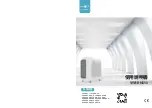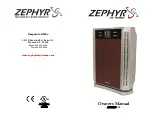
42
SS-SVX09A-EN
Installation
Air Vents
Vents must be installed at high points in the piping system to facilitate air purging during the filling
process.
Water Pressure Gauges
Install pressure gauge(s) to monitor the entering and leaving chilled water pressure.
NOTICE
To prevent evaporator damage, do not exceed 150 psig evaporator pressure.
Water Shutoff Valves
Provide shutoff valves in the “Supply” and “Return” pipe near the chiller so the gauge(s),
thermostats, sensors, strainer, etc., can be isolated during service.
Pipe Unions
Use pipe unions to simplify disassembly for system service. Use vibration eliminators to prevent
transmitting vibrations through the water lines.
Thermometers
Install thermometers in the lines to monitor the evaporator entering and leaving water
temperatures.
Balancing Valves
Install a balancing cock (valve) in the leaving water line. It will be used to establish a balanced flow.
Note:
Both the entering and leaving water lines should have shutoff valves installed to isolate the
evaporator for service.
Strainer
Install a pipe strainer in the water return line to protect the components from entrapped debris.
Chiller Drain
The chiller drain should be piped to a suitable drain facility to facilitate evaporator draining during
service or shutdown procedures. Provide a shutoff valve in the drain line.
Note:
The BPHE chiller does not include a drain plug. Drain piping and shutoff valve must be
installed at the lowest point in the water piping to insure proper draining of the chiller. Insure
that the drain is closed before filling system with water.
Chiller Flow Switch
Install a flow switch or other flow sensing device, illustrated in
Figure 23
, to prevent or stop the
compressor operation if the water flow drops off drastically. A flow switch ships with a each unit
when a “T” is included in the miscellaneous digit of the model number. Locate the device in the
chilled water supply line (water outlet) as shown in
Figure 22
. Refer to the field wiring and unit
schematics for the flow switch electrical interlock connections.
Water Temperature Sensor
The Temperature Sensor and Sensor-well must be installed in the leaving water piping as close to
the chiller as possible. Both devices are located inside the remote panel. Thermal paste is also
provided inside the remote panel and must be used when installing the sensor into the sensor-well.
Refer to
Figure 22
for the recommended location.
Figure 24
illustrates the Sensor-well dimensions.
Summary of Contents for RAUC-C20
Page 10: ...10 SS SVX09A EN Installation Figure 3 RAUC C20 Unit Dimensional Data Recommended Clearances...
Page 11: ...SS SVX09A EN 11 Installation Figure 4 RAUC C25 Unit Dimensional Data Recommended Clearances...
Page 12: ...12 SS SVX09A EN Installation Figure 5 RAUC C30 Unit Dimensional Data Recommended Clearances...
Page 13: ...SS SVX09A EN 13 Installation Figure 6 RAUC C40 Unit Dimensional Data Recommended Clearances...
Page 14: ...14 SS SVX09A EN Installation Figure 7 RAUC C50 Unit Dimensional Data Recommended Clearances...
Page 15: ...SS SVX09A EN 15 Installation Figure 8 RAUC C60 Unit Dimensional Data Recommended Clearances...
Page 55: ...SS SVX09A EN 55 Installation Field Connection Diagram Notes for all System Control Options...
Page 67: ...SS SVX09A EN 67 Installation Figure 33 6RT1 Discharge Air Sensor Assembly...
Page 96: ...96 SS SVX09A EN System Start Up Figure 47 20 Ton Pressure Curve...
Page 97: ...SS SVX09A EN 97 System Start Up Figure 48 25 Ton Pressure Curve...
Page 98: ...98 SS SVX09A EN System Start Up Figure 49 30Ton Pressure Curve...
Page 99: ...SS SVX09A EN 99 System Start Up Figure 50 40 Ton Pressure Curve per Circuit...
Page 100: ...100 SS SVX09A EN System Start Up Figure 51 50 Ton Pressure Curve per Circuit...
Page 101: ...SS SVX09A EN 101 System Start Up Figure 52 60 Ton Pressure Curve per Circuit...
















































